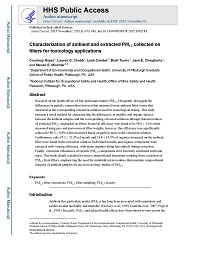Mining Publication: Characterization of Ambient and Extracted PM2.5 Collected on Filters for Toxicology Applications
Original creation date: October 2015
Authors: C Roper, LG Chubb, LK Cambal, B Tunno, JE Clougherty, SE Mischler
Research on the health effects of fine particulate matter (PM2.5) frequently disregards the differences in particle composition between that measured on an ambient filter versus that measured in the corresponding extraction solution used for toxicological testing. This study presents a novel method for characterizing the differences, in metallic and organic species, between the ambient samples and the corresponding extracted solutions through characterization of extracted PM2.5 suspended on filters. Removal efficiency was found to be 98.0 ± 1.4% when measured using pre- and post-removal filter weights, however, this efficiency was significantly reduced to 80.2 ± 0.8% when measured based on particle mass in the extraction solution. Furthermore, only 47.2 ± 22.3% of metals and 24.8 ± 14.5% of organics measured on the ambient filter were found in the extraction solution. Individual metallic and organic components were extracted with varying efficiency, with many organics being lost entirely during extraction. Finally, extraction efficiencies of specific PM2.5 components were inversely correlated with total mass. This study details a method to assess compositional alterations resulting from extraction of PM2.5 from filters, emphasizing the need for standardized procedures that maintain compositional integrity of ambient samples for use in toxicology studies of PM2.5.
